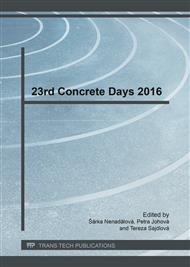p.164
p.173
p.178
p.184
p.190
p.198
p.203
p.209
p.215
Assessment of the Effects of Wind on Multi-Storey and High-Rise Concrete Building
Abstract:
Increase in the number of floors of high-rise buildings increases both vertical and horizontal loads, but at the same time increases the share of the total horizontal load stress in their individual load-bearing members. This stress must always be verified. At the same time, the height of the building also increases the horizontal deflection, resulting in increased requirements for the horizontal stiffness of the structure. The use of high-strength materials resulting in a reduction of dimensions of the load-bearing members and the weight of the building, results in a large slenderness of high-rise buildings. Ultimate limit states ULS. Serviceability limit states. Assessment of stability of the high-rise building under the effects of wind. Assessment of the effects of wind on floor slabs.
Info:
Periodical:
Pages:
190-197
Citation:
Online since:
May 2017
Authors:
Keywords:
Price:
Сopyright:
© 2017 Trans Tech Publications Ltd. All Rights Reserved
Share:
Citation:


